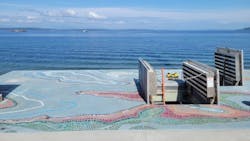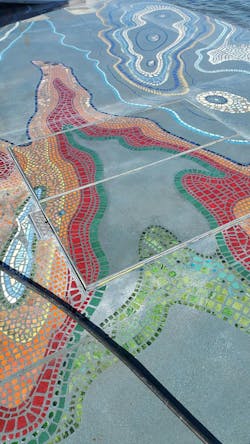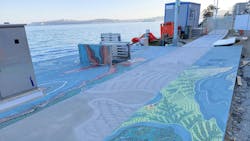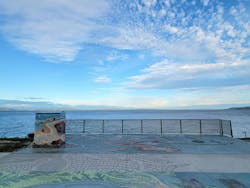How a pump upgrade got a facelift in Seattle
The population of Seattle has tripled since 1960, rising from just over one million residents to more than 3.5 million today. The city’s earliest settlers landed in West Seattle, which features the beautiful waterfront area of Alki Beach. The area includes a boardwalk that stretches for more than five miles and offers spectacular views of the Seattle skyline and Puget Sound.
As one of Seattle’s most desirable residential neighborhoods, the area has seen its population shift significantly over time. Once a charming neighborhood with mostly single-family homes, West Seattle and Alki Beach now includes many more multi-family residential buildings.
The population growth and transformation of the neighborhood placed additional stress on the city’s infrastructure, especially the Alki Pump Station. The station was built in 1959 and had reached the end of its useful life.
An aging airlift pump station design
Last year, Seattle Public Utilities completed the renovation of the pump station. The agency switched the station from an airlift style facility to one that used centrifugal pumps to meet the increased wastewater demands. The pump station is essential for moving sewage and stormwater from the surrounding area to a treatment plant.
As part of the project, SPU also incorporated a significant piece of the region’s history into the pump station. Artist Sarah Thompson Moore created “Tracing Alki”, a public artwork, for the station. Moore took four years in creating the project, which was inspired by a topographical map of Seattle printed in 1894.
“Through the use of iridescent and light refractive materials and a variety of textures, the artwork was created to interact with the natural environment, offering a unique experience with each visit,’’ Moore wrote on her website.
Residents of Alki, a community that thrives on embracing its past and its unique culture, overwhelmingly endorsed the project.
“Often wastewater utility projects are an out-of-sight, out-of-mind thing for the general public,’’ said Avery Reger, P.E., of SPU. “This project seized an opportunity to turn an otherwise unremarkable space into one that the public can truly appreciate, and it invites the public to better understand our wastewater system and our connection with the surrounding water bodies.”
The centrifugal pump plan
In an airlift system, also referred to as a pneumatic ejector, air compressors pressurize a sewage holding tank to force the wastewater up and out the force main. Over time, however, Alki’s air compressors and holding tanks deteriorated, demanding frequent maintenance. Replacement parts and equipment became increasingly hard to acquire.
“With improvements of modern pump technology, centrifugal pumps have become the norm for wastewater,’’ Reger said. “Increased electrical and hydraulic efficiency and ease of maintenance are just some of the benefits of electrically driven centrifugal pumps.”
The station retrofit included much more than the installation of centrifugal pumps. Workers dismantled and removed the existing airlift system. They also converted the existing structure into a separated wet well and dry wall configuration.
The project also called for replacing the 8-inch diameter force main with a 6-inch diameter force main; upgrading electrical and structural components and installing underground ventilation ducting, ducting and irrigation pipe. Construction began in 2022, but supply chain issues delayed the project’s completion.
“Delivery delays of motors, pumps, valves and electrical components were longer than anticipated and pushed the commission of the station beyond the originally planned completion date,’’ Reger said. “Additionally, unexpected work to structurally improve a portion of the seawall was needed.”
The conversion will reduce the risk of failure, improve system reliability and performance, and reduce maintenance costs.
SPU also added a safety guardrail along a seawall to protect the site. The guardrail was required to be compliant with local safety codes and includes stainless steel mesh panels with etched artwork. The guardrail is designed to be see-through while also providing a continuation of Thompson Moore’s artwork.
Installing Moore's artwork during construction
While Thompson Moore’s work was an important part of the project, determining how to incorporate it into the site was logistically challenging.
“One major complexity of construction involved the installation of the tile artwork,’’ Reger said. “The tiles needed to be installed integrally with the freshly poured concrete. The process started with the artist loosely gluing the intricate design of tens of thousands of tiles on a fabric scrim at their studio.”
The area covers about 1,200 square feet. It was divided into panels while the concrete was poured and tooled. “The artist worked with the contractor to precisely place the tile sheets,’’ Reger said. “After allowing the concrete to cure for a couple hours, the scrim backing was removed from the tiles. The intricate dance that was required for this process to be executed was complex but managed exceptionally well by all those involved.”
Some of the tiles were placed on two floor doors manufactured by BILCO, the manufacturer of specialty access products. The doors allow access to equipment for repair and replacement of parts.
The doors are equipped with a pan-type cover that can accept a variety of flooring materials. The cover is designed with a 1-inch fillable pan for field installation of architectural flooring material. In most instances, the terrazzo doors are used for interior applications. Harbor Pacific Contractors procured the doors for the project from Anderson Specialties, a manufacturer’s representative in Seattle.
“There were limited manufacturers that could produce a hatch with an inlay pan for the concrete and tile artwork that was to be installed,’’ Reger said. “Being able to extend the artwork on to the hatches was important for the artist’s vision and hides them in plain sight without affecting the accessibility of the station.”
One door was a 5-foot x 5-foot double leaf door, and the other was a single leaf door that measured 3-feet, 3-inches by 3-feet, 9-inches. The doors are also equipped with AASHTO H-20 wheel-loading, which allows for truck axle loading of 32,000 pounds.
SPU estimated the cost of the project at $1.2 million, and Thompson Moore consulted with the Muckleshoot Indian Tribe and other members of the community to develop the art work. SPU welcomed the community to visit the site in December to meet Thompson Moore and the project team.
“The feedback from the community was very positive,’’ Reger said. “Many people praised the thought-provoking, highly detailed artwork and had an appreciation for the dedication and effort of everyone involved to deliver a unique and enjoyable space.”
About the Author
Thomas Renner
Thomas Renner writes on building, construction, engineering and other trade industry topics for publications throughout the United States.



